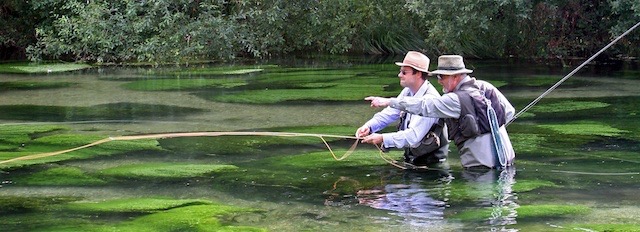
The author pointing out a nymphing fish to M. Laurent Sainsot of the International Ritz Fario Club of Paris, on the River Itchen. (Photo copyright Peter Lapsley)
What's in the book
Apart from over 200 photographs.
Chapter 1 pp 25 to 33
How fish see the dry fly
Most dry flies penetrate the surface film and are taken, preferentially, by
trout as emergers and not as hatched-out duns. This is the reason why the
ordinary angler can hope to, and does, do well using the classic dry fly. It
helps to understand what’s going on – but you don’t have to be either an
invertebrate nerd or a religious nut to succeed. Once you do understand
a bit more of what’s really going on you may well feel a stronger need to
move forward as a hunter of trout on your own terms, following your own
ideas rather than being spoon-fed.
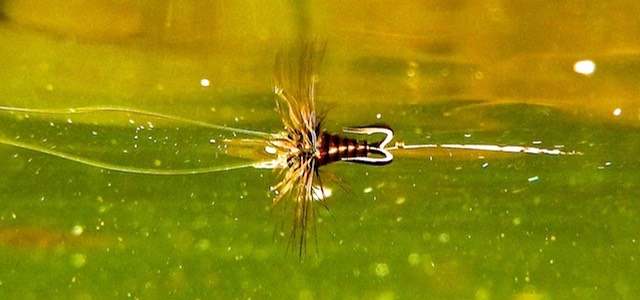
TROUT’S VIEW FROM BELOW, the fly having penetrated the surface, which acts as a mirror reflecting the river bottom.
(Photo copyright Peter Hayes)
Chapter 2 pp 35 to 45
Emerging Heresies
Here we are reviewing the evidence for the orientation of natural nymphs
as they rise and emerge at the surface – and finding that it is diametrically
opposite to the orientation with which our upstream imitation nymphs
and emergers are tied and fished. If we want to fool fish by giving them
the right GISSO (General Impression of Size, Shape and Orientation),
then we certainly need to use reversed nymphs, at least when presenting
them upstream in the surface film, or in the last inch below it. Ditto
emergers.
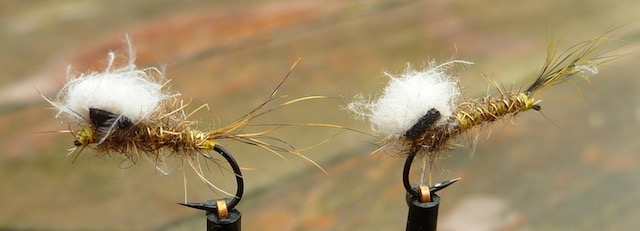
Suspender GRHE nymphs facing down stream, and up (Photo copyright Peter Hayes)
Chapter 3 pp 47 to 61
Hatched fly presentation
Our hatched dun imitations face the wrong way whenever the breeze is in
an angler’s face, whether they are fishing upstream or downstream. Did we
really want that to happen? The good old boys had it right in their imitations
of duns and also in their presentation of them. It was the angler’s job to
float the fly. The ‘dry fly revolutionaries’ wanted the fly to float itself by its
modern labour-saving design but it didn’t, they goofed and led the sport
astray in this and other respects, and you can be among the leaders of its
restoration if you enjoy a good rant and join me in this further heresy.
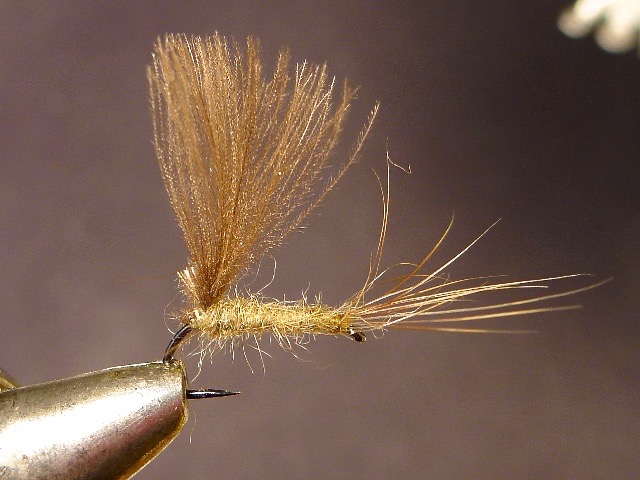
Reversed 'Kiss my Cul' (Photo copyright Peter Hayes)
Chapter 4 pp 63 to 73
How fish eat
The way our tippet tethers the fly and frustrates the trout in his attempts
to eat it is something that many anglers don’t consider, and something
that most angling writers have failed to address. Avoiding drag, generally
recognised as key to not putting fish off the take and causing rejection,
is also crucial, mechanically, in terms of the physics of getting the fly
into the trout’s mouth without it bumping out, hitting bone, or sparking
ejection. Loose tippet is the answer.

Focussed on a floating fly - zero drag! (Photo copyright Don Stazicker)
Chapter 5 pp 75 to 81
Casting every which way – but loose
I hesitate to instruct: I’m neither qualified nor good at it. What I try to
do here is to pass on my own experience for what it is worth, so that the
reader can try out the casting techniques I (and others) use, and see if they
work for you. All I can say is that there is a pretty solid body of conviction
and practice in the sport that uses the same drag-avoiding techniques –
and one which dates from at least as far back as Halford, writing in 1889.
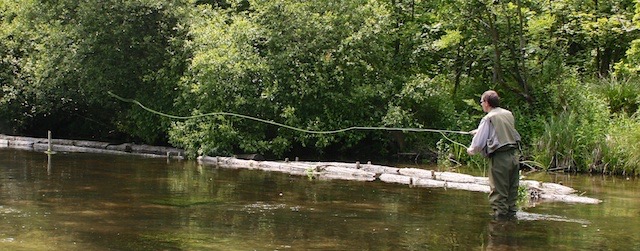
Richard Banbury using the dump cast on a particularly derisive Itchen trout (Photo copyright Peter Hayes)
Chapter 6 pp 83 to 87
How fish see the leader
You actively reduce your chances of hooking trout if you sink your dry fly
leader. I explain how and why, and if you follow my heresy and ensure that
it floats you will find I’m right and catch more fish. And we discuss ways
of approaching fish without scaring them in the light of their incredibly
sharp vision.(Please note, the advice to float your tippet does not apply to
dry fly fishing in still waters or dry fly fishing downstream, i.e. to situations in which
the trout is on the other side of the fly from yourself and focused on the surface).
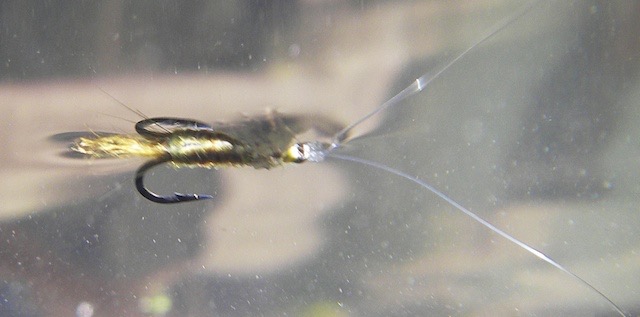
Fly seen in trout's mirror, tippet sunk (Photo copyright Peter Hayes)
Chapter 7 pp 89 to 97
Whatever floats your fly
This is a review of the development of fly floatants in the past and
recommendations for the present. Here again, quot homines, tot sententiae
– there are as many opinions as there are men to hold them, and everybody
has their favourites. I specify three products that I use for different
purposes and in different situations, each of which has its advantages.
For me, keeping flies made of CdC floating without discolouring them is
very important, as is keeping the leader in the surface film.
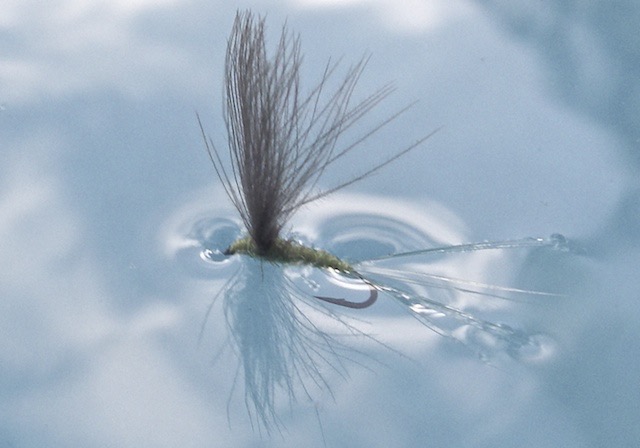
Kiss my Cul from above, treated to float (Photo copyright Peter Hayes)
Chapter 8 pp 99 to 109
Experiments outside the box
Other people’s earlier experiments with flies and fish may be anecdotal
in character and often lack the rigour of statistics – yet somehow, given
that they were undertaken by very serious people searching after angling
truths, one has to believe them. There are lessons in all of them for us
today, and I have not flinched from drawing the conclusions. You might
criticise me for this, but in my view ‘you better believe it’. And they are
fascinating.

Vincent Marinaro,A Modern Dry Fly Code (1950),p73 (Photo copyright Peter Hayes)
Chapter 9 pp 111 to 117
Fishing in rivers where you can’t see the fish
If, as I mainly do, you fish rivers that keep their trout from your gaze by
having a dark background or by being turbid, you can still go and learn
from rivers that you can see into and draw on the help of seen fish to give
you guidance on how to fish when the trout, and hence you, are ‘in the
dark’. There are more fish in front of you than you think. This chapter
provides straightforward help with turning unknown unknowns into
known unknowns.

Fifty Shades of Green-- a previously unseen trout rises for the second time on the R. Wylye (Photo copyright Peter Hayes)
Chapter 10 pp 119 to 125
Fishing so the fish can’t see you
This chapter is all about how not to scare fish. It concentrates specifically
on how to avoid scaring fish that are there in front of you but that you
can’t see. As well as examining the general principles of non-scary onstream
behaviour we look at the measures you can take to avoid rod flash
and line flash, and end up addressing the finer points of how the angler
can ‘dress to kill’.

Owain Mealing Fishing unseen by fish (Photo copyright Peter Hayes)
Chapter 11 pp 127 to 133
Can we get better fishing than we’ve got?
Most fly fishermen would agree on these three desiderata: more fishable
water; more (wild) fish; and more fly life. Can they have them? The
answer is yes, and in this chapter we look at how to improve the carrying
capacity of a fishery both for fish and for fly. We discuss the importance
of enhancing the sporting character of our fishing by concentrating
where possible on wild fish, and managing our fisheries for their benefit.
We look at physical river restoration, but also at the more radical idea of
biological restoration.

Re-energising the river: the author directs operations (Photo copyright The Wilton Fly Fishing Club)
Chapter 12 pp 135 to 155
Dry flies from outside the box
These 16 flies are the product of a fevered angling mind, and a great
deal of experimentation with trout whose reactions could be seen over a
period of more than 30 years. I didn’t invent them – I just stole the bits.
They are mainly fly designs rather than patterns – they are constructed
to perform in particular ways, on and in the surface, and you can tie
them in any colours and many materials to match the natural flies in the
waters you fish yourself. Basic tying instructions and some hints as to
their use are included, and full instructions for the ‘PhD’, the ‘Muskrax’,
and the ‘Hayestuck’.
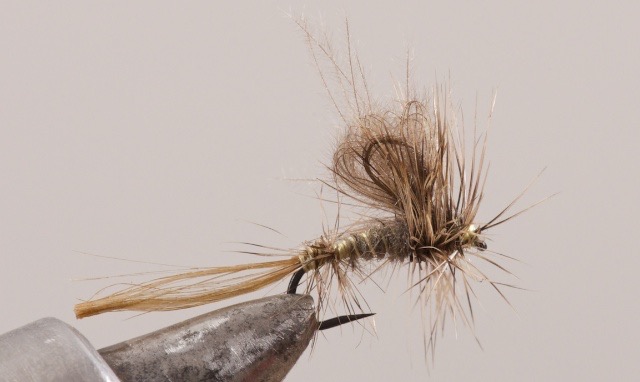
Hayestuck, emerger/ cripple (photo copyright Peter Hayes)
Chapter 13 pp 157 to 165
Tangential thoughts about nymphing
While I have a lot to say on the construction of dry flies I have very much
less to say on nymphs and nymphing. In contrast to the dry fly, where it
is my view that people have really gone a bit astray over the years, missing
some good opportunities for imitating items that trout want to eat as they see
them, the same is not really true of nymphs. Still, I’ve learned a few tricks,
developed a few very successful patterns, and I’m glad to pass them on.
We look at how nymphs behave in the water, and how they can be managed
to fit in with the expectations and feeding habits of the fish.
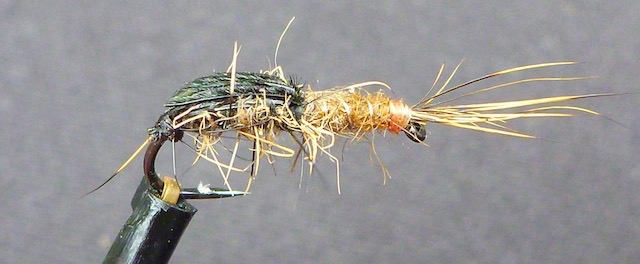
Reversed olive nymph (GRHE) to fish in film (photo copyright Peter Hayes)
Chapter 14 pp 167 to 175
The evening rise – what evening rise?
I thought it might be helpful to include a chapter on the kinds of strategies
one can use to approach difficult situations – and the evening rise (or the
lack of it) sprang to mind as one of our greatest challenges. So here we
have a look at the reasons why the evening rise is so problematical and
yet so important. Then we cover some practical ways of addressing them.

Spinnermalist (photo copyright Peter Hayes)
Chapter 15 pp 177 to 187
Pushing the envelope
This chapter deals with mimicking the hidden secrets of the trout’s
larder. It deals with the imitation of a bunch of little things that don’t look
very nice but which feature heavily in the diet of trout, and can in fact be
tied as flies and presented to the fish successfully, given a certain amount
of application on the part of the angler. Although these little critters are
not always easy to imitate, the results of success can be surprising, and
their use can account for some extremely big fish.

Chapter 16 pp 189 to 195
Imitation’s last frontier
Baetis (olives, that is) can account for as much as four-fifths of your small
upwing f lies, and all of them crawl beneath the surface to lay their eggs
and then float up as exhausted spinners, mostly to stick to the underside
of the surface film. A problem as yet only partly solved – but we review
some creative innovations, each of which gets us closer to a solution.
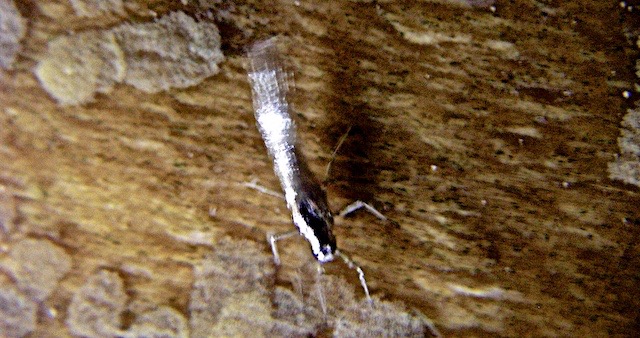
Plastron-silvered Female Olive (Baetis) egglayer, under water, with eggs. (photo Peter Hayes)
Chapter 17 pp 197 to 203
Playing and netting big trout
Getting to the point where you can confidently play and net big fish is a
steep learning curve with many points at which you can fall off and with
a high risk of disaster attending your efforts to learn. The stakes are high,
and the smaller your experience the scarier it is. So, no pressure then,
as they say. In this chapter we go through the logic of how best to take
away the fish’s advantages and empower your own. It’s the dos and don’ts
really, but it may help to add understanding in terms of the whys.
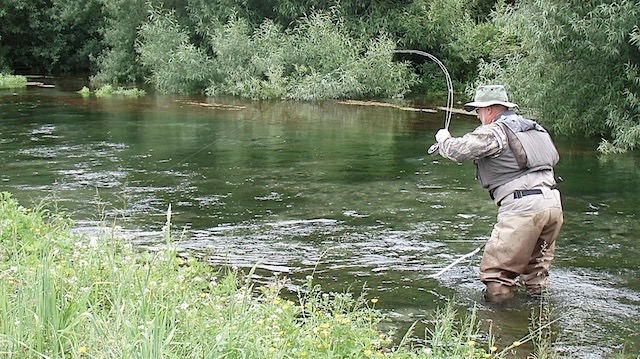
Keep the fish upstream of you (Photo by Owain Mealing)
Chapter 18 pp 205 to 215
Purism has got us facing the wrong way
The Dry Fly Revolution was initially a technical one, but became a moral
and ethical one when Halford took it over. With his harsh judgmental
light shining on the sport, facts as well as perceptions became twisted
in favour of fishing ‘perfectly dry’ at the peril of not being a gentleman.
The sporting, intuitive, and imitative development of fly fishing was
kidnapped and we still need to escape from the box we got put in. Worse
still, dry flies fished upstream face the wrong way when the wind is in
our face.

When did you last see your father ... use a nymph?
Chapter 19 pp 217 to 235
Reading outside the box
A fresh look at the history of fly fishing before we got put in the box.
From Berners to Halford they all fished floating flies, and fished them
as dry as they could. The past does inform the present. These Ancients
may have worn frock coats and tricorn hats but they were at least as clever
as we are, and much better fly fishermen than we have been allowed
to think. And they fished the dry fly not the wet. It was the hatched fly
they imitated. They wrote well and, if we read carefully, they tell us just
exactly how they fished . With 19th century tackle ‘improvements’
however, their flies got dragged below the surface, and floating your fly
got more difficult in the first half of that century.

John Worlidge on upstream wading,1675
Chapter 20 pp 237 to 243
Full circle with Tenkara ?
It is more than a little weird to see the modern, state-of-the-art, UK
fly fishing world being led back in full circle to those only-just-lost
simplicities and skills by this thing called Tenkara that comes to us from
undocumented, oral-tradition Japanese practices via the highly web-documented,
enthusiastic descriptions of new American aficionados. Our
own, much stronger, more highly developed and copiously documented
fly fishing tradition had effectively been suffocated. Nature abhors a
vacuum.

From Angling in Japan, M. Matuzaki, 1940
Chapter 21 pp 245 to 251
A philosophy of fly fishing, from outside the box
Because I take up such a robust position on so many things in fly fishing,
I thought it might help to understand where I am coming from if I tried
to give the reader some insights into my own personal beliefs about life
and fly fishing. But don’t worry, I stick pretty close to fly fishing and I
don’t wander off into any tragedies of personal life or worries about sex,
death and taxes.
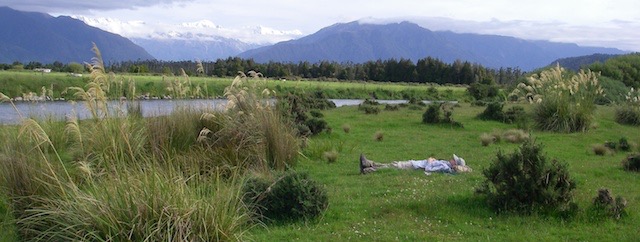
Taking a rest, Stephen Beville, Waitangitaona (photo copyright Peter Hayes)
Chapter 22 pp 253 to 256
Caudal Fin
A closing thought or two for fly fishing duffers, middle of the road
anglers and experts alike. Including...
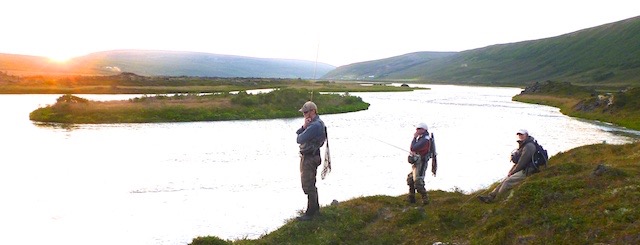
Three philosophers and no rise (photo copyright Peter Hayes)